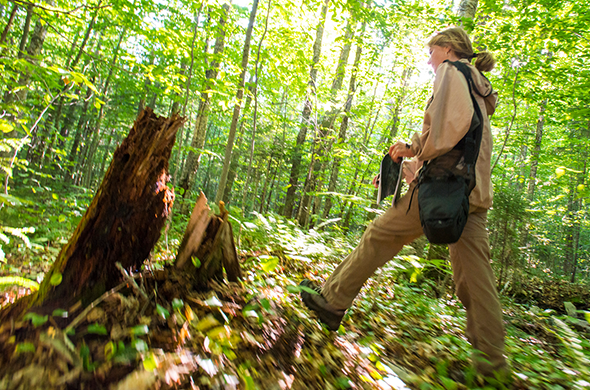Valleywide Vegetation Survey
 Project Overview:
Project Overview:
One of the core research efforts of the Hubbard Brook Ecosystem Study is the valley-wide vegetation survey. Since 1995, scientists have been tracking the growth and composition of trees in a grid of plots that spans the entire Hubbard Brook Experimental Forest. The plots were initially established by Paul Schwarz to look at spatial distributions of tree species in relation to topography and soils. Today, these data are critical because they give us an understanding of long-term patterns in tree abundance and ecosystem structure, as well as long-term effects of forest disturbances like air pollution and climate change.
Why It Matters
The key characteristic of the valley-wide vegetation survey is its scale. Every ten years, scientists identify and measure over 18,000 trees and saplings. This intensive effort gives a nuanced and statistically robust picture of the forest’s shifting structure and composition across a large and varied landscape. This is in contrast to many studies in ecology that are limited to smaller areas like individual stands or mountainsides. Being able to observe ecological structure and function at the scale of a broader landscape is essential for understanding both basic natural history and the effects of human-accelerated environmental change. The valley-wide vegetation survey also provides essential data for other research efforts at Hubbard Brook. For example, it helps ornithologists understand how shifting forest composition affects migratory birds.
Key Findings
The overall composition of the forest is stable over decades largely because of the long life span of the trees (300-400 years for the main species). However, there have been some shifts: yellow birch has significantly declined across the valley, as well as declines in the abundance of paper birch and red maple. Conifers, on the other hand, are becoming more abundant. The rates of recruitment for red spruce and balsam fir are exceeding mortality.
Despite expectations that over time, as the climate warms, conifer abundance will shift upslope where temperatures are cooler, the valley-wide vegetation survey has shown increases in conifer abundance everywhere—upslope in the spruce-fir zones and downslope in the hardwoods, reflecting a return of these species to the landscape from which they were logged in early 1900s.
Beech bark disease, which causes cankered bark and increased tree mortality, has drastically altered northern hardwood forests throughout the northeastern US. At Hubbard Brook, the valley-wide vegetation survey has shown that the severity of cankering and growth suppression due to beech bark disease is higher in lower elevations. Inversely, American beech trees at higher elevations are healthier and the abundance of American beech upslope has increased.
Watershed 6, which serves as Hubbard Brook’s biogeochemical reference watershed, is an outlier when it comes to vegetation. This small watershed has significantly more American beech and sugar maple and significantly less red spruce, balsam fir, and yellow birch than the surrounding valley. Watershed 6 has also experienced more severe sugar maple mortality than the surrounding valley. These findings are important because they illustrate that the vegetation patterns captured at a larger scale would not be visible from only sampling in this smaller, intensely studied portion of the forest.
How the Study is Conducted
The valley-wide vegetation survey takes place every ten years. Each survey takes a team of 5–6 researchers about five months, over the course of two field seasons, to sample the 371 permanent plots. The researchers identify, measure, and tag all live trees larger than 10 centimeters in diameter in circular areas surrounding each plot point. The plots are laid out along a grid across the experimental forest, with the exception of six south-facing experimental watersheds. The next survey is planned to start in 2025.
Principal Investigators:
Battles, J. J., Cleavitt, N. L., Saah, D. S., Poling, B. T., & Fahey, T. J. (2017). Ecological impact of a microburst windstorm in a northern hardwood forest. Canadian Journal of Forest Research, 47(12), 1695–1701. https://doi.org/10.1139/cjfr-2017-0206
Battles, J. J., Fahey, T. J., Driscoll, C. T., Blum, J. D., & Johnson, C. E. (2013). Restoring Soil Calcium Reverses Forest Decline. Environmental Science & Technology Letters. https://doi.org/10.1021/ez400033d
Cleavitt, N. L., Battles, J. J., Fahey, T. J., & Blum, J. D. (2014). Determinants of survival over 7 years for a natural cohort of sugar maple seedlings in a northern hardwood forest. Canadian Journal of Forest Research, 44(9), 1112–1121. https://doi.org/10.1139/cjfr-2014-0177
Cleavitt, N. L., Battles, J. J., Fahey, T. J., & Doorn, N. S. van. (2021). Disruption of the competitive balance between foundational tree species by interacting stressors in a temperate deciduous forest. Journal of Ecology, n/a(n/a). https://doi.org/10.1111/1365-2745.13687
Cleavitt, N. L., Battles, J. J., Johnson, C. E., & Fahey, T. J. (2017). Long-term decline of sugar maple following forest harvest, Hubbard Brook Experimental Forest, New Hampshire. Canadian Journal of Forest Research, 48(1), 23–31. https://doi.org/10.1139/cjfr-2017-0233
Cleavitt, N. L., Fahey, T. J., & Battles, J. J. (2011). Regeneration ecology of sugar maple (Acer saccharum): Seedling survival in relation to nutrition, site factors, and damage by insects and pathogens. Canadian Journal of Forest Research-Revue Canadienne De Recherche Forestiere, 41(2), 235–244. https://doi.org/10.1139/x10-210
van Doorn, N. S., Battles, J. J., Fahey, T. J., Siccama, T. G., & Schwarz, P. A. (2011). Links between biomass and tree demography in a northern hardwood forest: A decade of stability and change in Hubbard Brook Valley, New Hampshire. Canadian Journal of Forest Research-Revue Canadienne De Recherche Forestiere, 41(7), 1369–1379. https://doi.org/10.1139/x11-063
Current Projects
We combine long-term monitoring with visionary experiments to advance our understanding of forest ecology.
